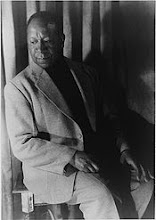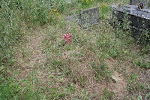In an article entitled "Beauford's Street Scenes," published on August 17, 2024, I expressed my belief that the painting shown in the image below represented the elevated train (metro) that serves the south and southwest parts of the city of Paris.
My reasoning was based on the date of the painting, which is 1968. (Beauford never returned to New York City after he moved to Paris in 1953.)
(1968) Oil on canvas
Signed and dated "BEAUFORD DELANEY 1968" lower right
© Estate of Beauford Delaney,
by permission of Derek L. Spratley, Esquire,
Court Appointed Administrator
When I recently compared it to the painting sold by Swann Auction Galleries in October 2024, I was prompted to rethink my original supposition.
(circa 1945-46) Oil on linen canvas
457x546 mm; 18x21½ inches.
Signed and dated (indistinctly) in oil, lower right recto.
Signed (three times) and inscribed "181 Greene St" (twice)"
and "NY" in oil on the stretcher bars, verso.
© Estate of Beauford Delaney
by permission of Derek L. Spratley, Esquire,
Court Appointed Administrator
Though the color palettes used for these works is strikingly dissimilar, the composition of the scenes depicted is virtually identical.
In both works, a viaduct dominates the center of the scene. Three of its pillars are clearly visible, and a street lamp with a round lantern is visible beneath it.
In both works, buildings are depicted behind the viaduct. The angles at which they are portrayed are somewhat different, but there is similarity in the roof lines (note the step-like structure of the roof of the second of the four buildings at the right of both paintings).
The placement of the buildings in relation to the viaduct's pillars on the right side of the painting is identical. On the left side of the 1968 painting, a building appears to be "missing."
The horizontal center of both paintings is filled with ground-level building façades. Beauford favored round windows for these structures in his circa 1945-46 work, whereas only the building at the far left has (indistinctly) round "windows" in the 1968 work.
In the 1940s painting, Beauford has clearly indicated a short, round street sign in the foreground.
In the 1968 painting, he has included a similar but indistinct object of the same size and approximate placement.
Finally, Beauford has placed two figures - one stationary and one walking - in each painting. Their locations are different, and the stationary figures are not clearly identifiable as human.
Given the similarity of these works, created almost 25 years apart, one has to wonder whether Beauford worked from a photo of this location when he painted each of these street scenes.
Another possibility is that he had a photo of his 1940s work that inspired the one he painted in 1968.
A future visit to the University of Tennessee Libraries to peruse the photos in the Beauford Delaney Papers might yield some answers!
* Street Scene, 1968 is the first work of art people see when they visit the Paris Noir exhibition at the Centre Pompidou in Paris. Read about Beauford's prominence in the exhibition HERE.










No comments:
Post a Comment